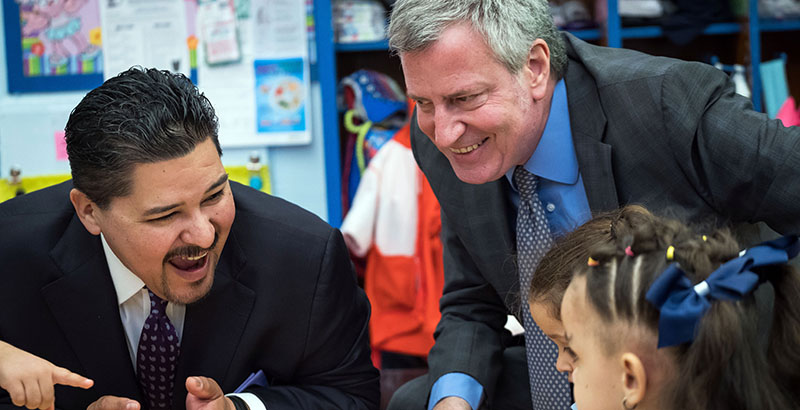Mayor Bill de Blasio Wants to Diversify New York City Schools, Chancellor Richard Carranza Wants to Desegregate. Is That a Problem?

The annual mobilization of 1 million young human beings into classrooms to begin or resume their education is probably the happiest day per capita on the New York City school district calendar.
That mood pervaded Mayor Bill de Blasio’s morning press conference last week at an Ozone Park, Queens, primary school with his ebullient new schools chancellor, Richard Carranza.
“He was grinning this morning when I saw him,” de Blasio said. “This is someone who really loves what he does.”
Carranza has said that “there’s no daylight between Mayor de Blasio and myself,” and his remarks at P.S. 377 on the first day of school accentuated their like-mindedness. He called Equity and Excellence for All, de Blasio’s plan for improving student performance that has been faulted by critics as vague and unstrategic, “one of the beacons of light which brought me to New York City.”
He maintained that “there are no other cities across America that have provided the access, the universal access, to pre-K” like New York City, and he told the mayor that “you need to take a bow for your leadership in setting a vision” for the 3-K for All early education program. (The city is a leader but not alone in offering universal pre-K for 3-year-olds.)
There were hints that the two men may not be working off the same agenda, however, which may have reflected minor stylistic differences in talking about inequity in schools or a more significant disconnect.
Carranza has rarely felt the need to be circumspect during his five months on the job. He listed “desegregating the schools” as the top challenge facing the country’s largest school district after a citywide listening tour in the spring. He called school admission screens “antithetical” to public education.
“The conversation around segregation is not divisive,” he was quoted as saying by Chalkbeat. “Because the conversation around integration is American.”
Carranza never said the words “segregation” or “desegregation” in describing his goals at the press conference, even when a reporter asked for “your thoughts about desegregation.” De Blasio, who has been faulted for refusing to describe New York City schools as “segregated,” didn’t use these words either.
“I don’t think the mayor understood the level of criticality, of being critical, that Carranza brought,” said Matt Gonzales, director of the school diversity project at New York Appleseed, a nonprofit group that works to integrate schools. “It requires a lot of humility to hear that the entire school district needs to be fixed.”
The city’s diversity plan, published last June, prior to Carranza’s arrival, avoided traditional descriptions of racial and ethnic divisions by focusing on whether schools are “racially representative” of the district’s total composition.
That strategy seemed in evidence when de Blasio was asked on Wednesday about “potential middle school desegregation” in Brooklyn’s District 15, where he raised his children and served on the local school board. He called the parent-led proposal, which would end the use of academic screens in middle school, “an opportunity to diversify classrooms in a positive, constructive way.”
Another reporter asked the mayor what he thought of Carranza having characterized New York City in July as “one of the most segregated school systems” (he also said city policies had “created a permanent underclass“). De Blasio said, “We’re unified that we’re going to be making a series of changes.”
“Broadly speaking, I think the two are closely aligned,” said Richard Kahlenberg, a senior fellow at The Century Foundation who advises city education officials on diversity issues. “Mayor de Blasio has suggested his goal is to make New York ‘the fairest big city in America.’ Chancellor Carranza has said, ‘Let’s start acting on’ Brown v. Board of Education. At the end of the day, you can’t be the fairest city in the country unless you tackle school segregation.”
De Blasio noted that public sentiment “has changed the dynamics in favor of diversification efforts.” His proposal to eliminate the specialized school admissions test reflected Carranza’s priorities but also responded to growing evidence that New Yorkers are unwilling to tolerate elite public schools that are only 10 percent black or Hispanic in a system where nearly 70 percent of students describe themselves that way.
But here, too, the mayor seems to have stopped short of Carranza’s more radical opposition to academic screens anywhere. The mayor’s plan requires a vote by state lawmakers to change the 1971 specialized school law, which political observers consider unlikely. But some say he has the authority to unilaterally end the test in five newer specialized schools. He says city lawyers are looking into the matter.
Others are skeptical. De Blasio made up “the legal question [about the five newer schools] out of whole cloth and buried it in the bowels of the corporation counsel,” David Bloomfield, a professor of education law at Brooklyn College, told The 74 in June.
“It’s a lack of political courage,” he said.
But advocates remain optimistic.
“A year ago we didn’t think the level of conversation that Carranza brings would even be possible,” said Gonzales. “I want to see him convince Mayor de Blasio that the city and the communities want these changes.”
Get stories like these delivered straight to your inbox. Sign up for The 74 Newsletter

;)
